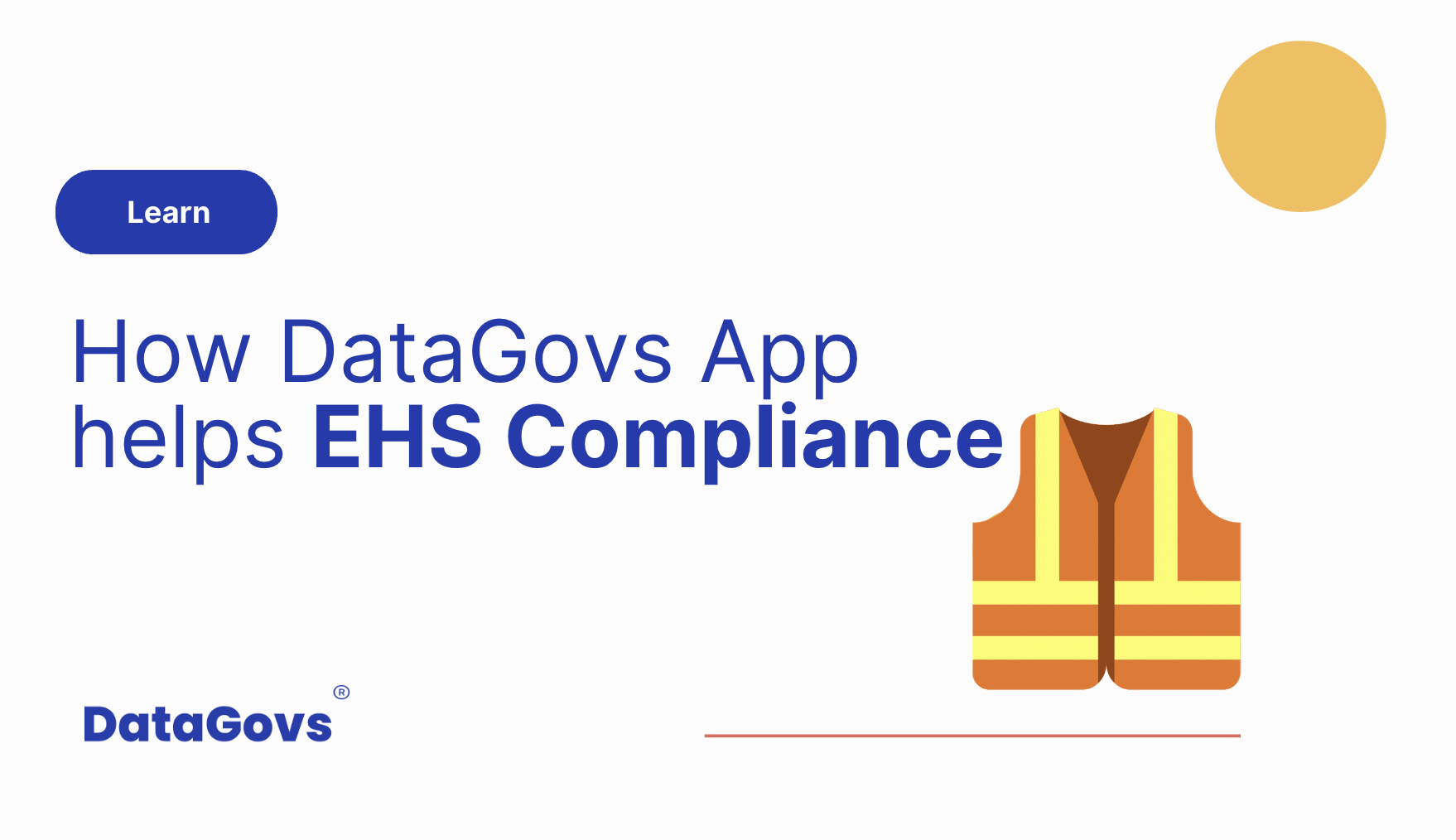How DataGovs App Helps EHS Compliance

Environment, Health, and Safety (EHS) compliance is big across industries. At DataGovs, our compliance mobile app helps the team leverage our infrastructure to stay in compliance with EHS use cases at scale. We strive to give the best customer support and deliver apps that make it easy to onboard your teams at scale. Here is how.
What is Environment, Health, and Safety (EHS)?
Broadly it means taking regulations, policies, and practices together to ensure a safer work environment. The regulations vary across organizations with the government giving specific guidelines and standards to ensure compliance.
-
Environmental: Environmental considerations focus on managing and minimizing the impact of human activities on the natural surroundings. This includes addressing issues like pollution control, waste management, resource conservation, and sustainability.
-
Health: Health aspects of EHS are concerned with safeguarding the well-being of individuals. This involves identifying and managing potential health hazards in the environment, such as exposure to hazardous substances, air and water quality, noise pollution, ergonomic concerns, and occupational health risks.
-
Safety: Safety measures encompass preventing accidents, injuries, and other harmful incidents. This includes maintaining a safe working environment, implementing safety protocols, providing appropriate protective equipment, conducting risk assessments, and promoting safety awareness and training.
The Problem with EHS in the Digital Age
Organizational teams practicing EHS in the digital world face challenges in manual processes involving papers, spreadsheets, emails, and legacy systems. The increase in data created across teams also makes it harder to manage and analyze data.
-
Data Management
-
Tech Adoption
-
Compliance Changes
-
Remote Work
-
Training and Upskilling
The Opportunity in EHS in the AI Age
In the AI age, everyone is looking at how AI will replace workers but for EHS teams it can make them more effective in their work. Specifically in saving time and money, and analyzing data to get to decisions faster across departments. What are some of these opportunities?
-
Risk Assessment: AI can analyze historical data, identify patterns, and help EHS teams assess risks more accurately. Mobile apps can be used to collect real-time data on-site, enabling EHS teams to make informed decisions and mitigate risks promptly.
-
Incident Reporting and Investigation: Mobile apps can streamline incident reporting processes by providing a user-friendly interface for capturing incident details, attaching photos or videos, and documenting witness statements. AI can aid in incident investigation by analyzing data to identify root causes, contributing factors, and trends.
-
Safety Training and Education: Mobile apps can deliver interactive safety training modules, making learning accessible anytime, anywhere. AI-powered chatbots can provide personalized guidance, answer questions, and reinforce learning.
-
Compliance Monitoring: AI can assist EHS teams in monitoring compliance with regulatory requirements by analyzing large volumes of data from various sources, such as sensors, IoT devices, and documentation.
-
Emergency Response and Communication: Mobile apps equipped with AI capabilities can be valuable during emergency situations. AI algorithms can analyze incoming data during emergencies, such as incident reports or sensor data, and provide real-time recommendations for immediate response actions.
-
Data Analysis and Predictive Analytics: AI can analyze large volumes of EHS-related data, such as incident reports, inspection data, and environmental monitoring data, to identify trends and patterns.
-
Auditing and Inspections: Mobile apps can digitize the auditing and inspection processes, enabling EHS teams to conduct assessments efficiently and consistently. AI can assist in automating routine checks, identifying non-compliance issues, and prioritizing corrective actions. AI algorithms can also analyze inspection data to identify areas of improvement and recommend best practices.
The Return on Investment (ROI)
The specific ROI will depend on the size of the organizations, the industry, and the complexity of the implementation. At DataGovs, we generally see benefits in the level of automation accomplished that reduces overhead, closes issues, and saves analyst time on tasks.
-
Reduced Incident Costs: By using AI to identify patterns and analyze incident data, EHS teams can implement proactive measures to prevent accidents and reduce incidents.
-
Improved Compliance: AI-powered monitoring of compliance with environmental, health, and safety regulations can help identify areas of non-compliance in real time.
-
Enhanced Efficiency: Mobile apps and AI-driven automation streamline processes such as incident reporting, inspections, and data analysis, reducing manual effort and associated administrative costs.
-
Enhanced Risk Mitigation: AI algorithms can analyze historical and real-time data to identify potential hazards, assess risks, and recommend preventive measures.
-
Improved Training Effectiveness: Mobile apps and AI-powered training platforms provide interactive and personalized safety training.
How DataGovs Compliance App Helps
As more teams recognize the value of various artificial intelligence tools, integrating them into their processes will become a challenge. Every AI tool is different and DataGovs makes implementing any model across various data systems easier, regardless of specific formats.
This helps analyze data faster for compliance-related sources like regulatory databases, environment monitoring systems, incident reports, and safety documentation.
Here’s how the use of agnostic AI models can help EHS teams through a compliance app:
-
Data Integration: Avoid vendor lock-in with seamlessly integrating data from diverse sources, including structured databases, unstructured documents, and real-time sensors.
-
Standardization: Agnostic AI models can process and standardize data formats, regardless of their origin or structure.
-
Automated Data Analysis:y leveraging machine learning techniques, these models can learn from historical data, detect non-compliance issues, and provide insights to EHS teams regarding potential risks or areas for improvement.
-
Real-time Monitoring: With agnostic AI models, the compliance app can provide real-time monitoring of compliance-related activities.
-
Predictive Analytics: Agnostic AI models can leverage historical compliance data and perform predictive analytics to forecast potential compliance issues.